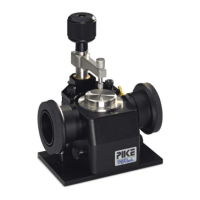PN 350-025004-09
Page | 12
High-Pressure Clamps
The high-pressure clamps consist of the base which attaches directly to the accessory’s top plate, the
stainless steel pressure tip arm and the pressure control knob with built in slip-clutch mechanism. A
removable anvil is located underneath the pressure module. This anvil is positioned in the center of the
crystal plate and provides direct pressure to the sample. The pressure clamp module rides up and down
on a lead screw located in the clamp column, with its position adjusted by the control knob. The control
knob features a ratchet-type clutch mechanism that controls the maximum allowable pressure and
protects the crystal from over tightening.
High-Pressure Clamp Installation
1. Position the clamp on the two dowel pins located on the top plate of the MIRacle accessory.
Please note that the top plate extends approximately 1/4" beyond the MIRacle base. The clamp
mount provides a space to accommodate for this extension. Before the clamp can be fully
mounted on the pins, the plate extension and the groove in the clamp mount must be perfectly
aligned.
2. Press the clamp down until the pins fully engage. Using a flat head screwdriver, tighten the captive
screws so the clamp is firmly attached to the accessory base.
3. As with the micrometer pressure clamp, the high-pressure clamps are provided with three
pressure tips; swivel, flat and concave. However, the swivel tip for the high-pressure clamp is
made of metal vs. white plastic due to the higher sampling forces involved.
4. The clamp is now ready for use.
The high-pressure clamp models are able to swing to the side for ease of cleaning. The slip clutch knob is
used for applying pressure to the sample without over tightening. A detent holds the pressure clamp tip
in place directly over the crystal.
Crystal Cleaning
The solvent used for cleaning your crystal is dependent on the sample that has been analyzed. In all
cases it is best to attempt to clean the crystal with the mildest solvent possible. For most cases, the
preferred solvent is isopropyl alcohol. If a stronger solvent is required, acetone may be used. In all cases
when using solvents, inspect the materials safety data sheet associated with the solvent you are using
and comply with any recommended handling procedures. Apply the solvent to the crystal with a cotton
swab and gently remove using a cotton swab or non-abrasive wipe. Repeat this procedure until all traces
of the sample have been removed. Under no circumstances should the softer crystal materials (ZnSe,
Ge) be rubbed with paper products such as Kleenex® or Kimwipes®. Many paper products are abrasive
and could cause scratching of the softer crystal surfaces.
CAUTION: Do not submerge the crystal plate or allow liquid to flow over the top of the crystal plate. This
will damage sensitive optics.

